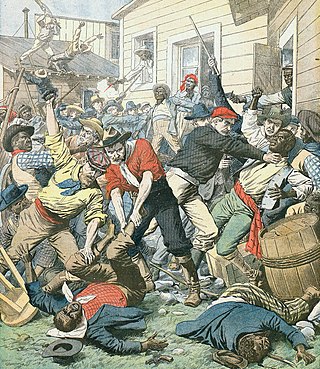
Lowndes County is a county located in the south central portion of the U.S. state of Georgia. As of the 2020 census the population was 118,251. The county seat is Valdosta. The county was created December 23, 1825.

Brooks County is a county located in the U.S. state of Georgia, on its southern border with Florida. As of the 2020 census, the population was 16,301. The county seat is Quitman. The county was created in 1858 from portions of Lowndes and Thomas counties by an act of the Georgia General Assembly and was named for pro-slavery U.S. Representative Preston Brooks after he severely beat abolitionist Senator Charles Sumner with a cane for delivering a speech attacking slavery.

Valdosta is a city in and the county seat of Lowndes County, Georgia, United States. As of 2019, Valdosta had an estimated population of 56,457.

The South Florida Railroad was a railroad from Sanford, Florida, to Tampa, Florida, becoming part of the Plant System in 1893 and the Atlantic Coast Line Railroad in 1902. It served as the southernmost segment of the Atlantic Coast Line's main line. The line remains in service today and is now part of the Central Florida Rail Corridor in the Orlando metro area. The rest of the line remains under the ownership of CSX Transportation as part of their A Line.

The Wiregrass region, also known as the Wiregrass plains or Wiregrass country, is an area of the Southern United States encompassing parts of southern Georgia, southeastern Alabama, and the Florida Panhandle. The region is named for the native Aristida stricta, commonly known as wiregrass due to its texture.

The Plant System named after its owner, Henry B. Plant, was a system of railroads and steamboats in the U.S. South, taken over by the Atlantic Coast Line Railroad in 1902. The original line of the system was the Savannah, Florida and Western Railway, running across southern Georgia. The Plant Investment Company was formed in 1882 to lease and buy other railroads and expand the system. Other major lines incorporated into the system include the Savannah and Charleston Railroad and the Brunswick and Western Railroad.

The Atlantic and Gulf Railroad was chartered in February 1856 by act of the Georgia General Assembly. It was also known as the Main Trunk Railroad. It traversed south Georgia from Screven to Bainbridge, Georgia. Construction began in early January 1859. Its construction was halted by the American Civil War. Construction began again after the end of the war and the line was completed to Bainbridge, Georgia by late December 1867. The route never reached all the way to the Gulf of Mexico as it had originally had intended. The company went bankrupt in 1877 and was bought in 1879 by Henry B. Plant and became incorporated into his Plant System. Its main line is currently operated by CSX Transportation. Throughout its history, the Atlantic and Gulf was closely associated with the Savannah and Albany Railroad Company and its successor the Savannah, Albany, and Gulf Railroad.
The Brunswick and Western Railroad is a historic railroad in southern Georgia that at its greatest extent ran from Brunswick near the coast to Albany. Segments of the line still exist today. The Brunswick and Florida Railroad ran from Brunswick west to Glenmore, where it would connect with the Atlantic and Gulf Railroad.

Withlacoochee State Trail is a 46-mile (74 km) long paved, multi-use, non-motorized rail trail in Florida located in Citrus, Hernando and Pasco counties. It follows along the Withlacoochee River and passes through the Withlacoochee State Forest. It is the longest paved rail trail in Florida.

The Withlacoochee River or Crooked River is a river in central Florida, in the United States. It originates in the Green Swamp, east of Polk City, flowing west, then north, then northwest and finally west again before emptying into the Gulf of Mexico near Yankeetown. The river is 141 miles (227 km) long and has a drainage basin of 1,170 square miles (3,000 km2). It is believed to have been named after the Withlacoochee River in the northern part of the state, near the border with Georgia.

The Withlacoochee River originates in Georgia, northwest of Nashville, Georgia. It flows south through Berrien County where it joins the New River and forms part of the boundary between Berrien and Cook counties. It then flows south into Lowndes County, Georgia. At Troupville, Georgia the Little River joins the Withlacoochee River flows continues to flow south and forms part of the boundary between Lowndes and Brooks counties in Georgia. The river then flows into Florida for 1.34 miles before returning into Georgia for an additional 2.44 miles. It then returns to Florida, forming the northeast boundary of Madison County, Florida and the western boundary of Hamilton County, Florida and eventually merges with the Suwannee at Suwannee River State Park west of Live Oak. The river is 115 miles (185 km) long. It is believed to be the source for the name of the central Florida river of the same name.

Clyattville is an unincorporated community and census-designated place (CDP) in Lowndes County, Georgia, United States. It was established in the 1840s.

On May 16, 1918, a plantation owner was murdered, prompting a manhunt which resulted in a series of lynchings in May 1918 in southern Georgia, United States. White people killed at least 13 black people during the next two weeks. Among those killed were Hayes and Mary Turner. Hayes was killed on May 18, and the next day, his pregnant wife Mary was strung up by her feet, doused with gasoline and oil then set on fire. Mary's unborn child was cut from her abdomen and stomped to death. Her body was then repeatedly shot. No one was ever convicted of her lynching.
The Alapahoochee River is a 14.4-mile-long (23.2 km) tributary of the Alapaha River in Georgia and Florida in the United States. Via the Alapaha and Suwannee rivers, its waters flow to the Gulf of Mexico.

The Little River is a 105-mile-long (169 km) tributary of the Withlacoochee River in the U.S. state of Georgia. Via the Withlacoochee and the Suwannee River its waters flow to the Gulf of Mexico. The Little River was also known historically as the Ockolocoochee River.

State Route 133 (SR 133) is an 82.8-mile-long (133.3 km) southeast-to-northwest state highway in the southwestern part of the U.S. state of Georgia. It travels through portions of Lowndes, Brooks, Colquitt, Worth, Dougherty, and Lee counties. It connects the Valdosta and Albany areas.

State Route 122 (SR 122) is a 98.2-mile-long (158.0 km) state highway that travels west-to-east through portions of Thomas, Brooks, Lowndes, Lanier, Clinch, and Ware counties in the southern part of the U.S. state of Georgia. The highway connects the cities of Thomasville and Waycross, via Lakeland.
The Macon and Brunswick Railroad ran from Macon, Georgia to Brunswick, Georgia. Its construction was interrupted by the American Civil War, and initially only ran from Macon to Cochran, Georgia. The 5 ft gauge line was completed and extended to the Georgia coast when it opened in its entirety in December 1869. Construction of the line stimulated the lumber industry along its path, and the founding of new towns and counties.
Sabal Trail Transmission Pipeline is a natural gas pipeline that runs from central Alabama through southwest Georgia to Orange County, Florida. A minority stake in the venture is owned by NextEra Energy and Duke Energy. The pipeline has been being planned since before 2011. In July 2013 it was announced that Florida Power & Light Company (FPL) jointly awarded its parent corporation, NextEra Energy and Spectra Energy the bid to build the pipeline. In May 2015, Duke Energy bought an interest in the venture. Construction began in September 2016. The pipeline is currently scheduled to be in service by June 2017.

















